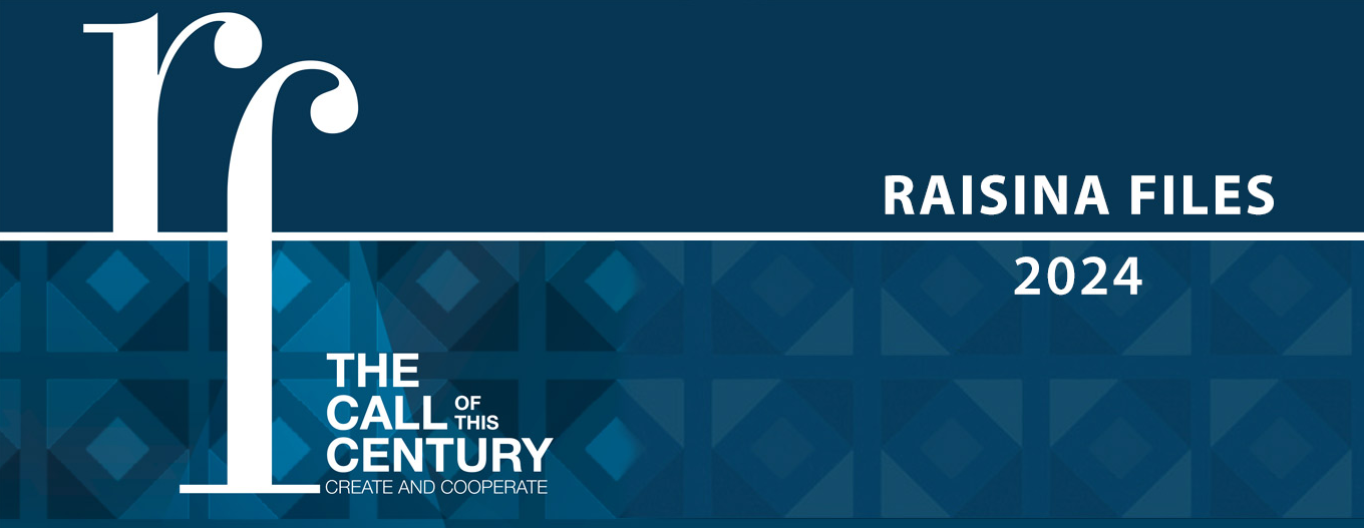
This article is a part of the series - Raisina Files 2024
India’s G20 Presidency was a watershed moment in the global conversation on digital public infrastructure (DPI). In August 2023, the definition of DPI was collectively understood, and encoded in the outcome document of the G20’s Digital Economy Working Group (DEWG) as a set of interoperable digital systems built on open standards to promote access to government and private services for all.[1] Shortly thereafter, in the New Delhi Declaration of September 2023,[2] Prime Minister Narendra Modi announced two India-led initiatives to build on the successes of the DEWG: a Global Digital Public Infrastructure Repository, and a social impact fund called One Future Alliance (OFA).
The repository is a critical resource to make knowledge and lessons on DPI available to the world;[3] the fund is envisioned as a multilateral institution to build capacity, provide funding and offer technical assistance to synergise global efforts on the development of DPI.[4] These initiatives have led to increased enthusiasm to build DPIs as a solution for fostering efficiencies in public service, more competitive markets, and enhanced innovation, especially for low- and middle-income countries (LMICs).
In parallel to India’s G20 presidency, various joint statements coming from the governments of India and the United States (US)[5] declared their commitment to working together to provide global leadership for the implementation of DPI. The subject of DPI was also discussed in statements released by the Quad,[6] the Shanghai Cooperation Organisation (SCO),[7] and in the European Union-India Trade and Technology Council[8] which also focused on promoting secure, privacy-preserving DPI for developing countries. These diplomatic efforts have been supplemented by organisations such as Co-Develop that work to accelerate the adoption of DPI at scale, as well as advocacies such as ‘fifty in five’[9] which seeks to push the design, launch and scale components of DPI in 50 countries by 2028.
The development of DPI is critical and needs a robust ecosystem in countries to be able to develop, deploy, implement and govern the infrastructure meaningfully. DPI should be built to be inclusive—i.e., they should reduce the economic, social and technical barriers to last-mile access; be embedded in rights-preserving approaches to planning, design, and operation; and ensure space for participation of community actors, the private sector, and citizens. DPI should also ensure sustainability through multi-stakeholder partnerships, which can offer different types of financing and enhance accountability. To ensure all this, countries should be ready to find willing recipients that engage with the DPI discourse meaningfully, with the appropriate readiness and human, financial, institutional scaffolding that is necessary to make the technology a success.
This global momentum to demystify DPI, and to ensure diplomatic validation and funding mechanisms for any country that might be interested in building digital infrastructure, is starting to come together. One piece of the puzzle, however, is missing from the public discourse: an assessment of specific, contextual needs of the countries that will implement DPIs. The current effort is still structured towards the “supply” of DPI, which while important does appear to be a top-down approach where the LMICs are seen as recipients of new approaches to technologies. While the stress on building in-country markets, innovation, and public sector capacity exists, it is also necessary to synergise DPI agendas with in-country priorities, capacities and trade-offs. There are early indications of thinking through DPI at the country level. There is, for instance, Co-Develop’s new research on the “State of DPI''[10] meant to understand the gaps and opportunities for development actors to support DPI adoption and safeguarding. However, a framework to self-assess needs and pursue the DPI approach more strategically is required by countries interested in pivoting their digital infrastructures to this new mould.
Needs Assessments
Countries are adopting multiple pathways to digitalisation as it increasingly becomes inevitable. One pathway can lead countries to a vendor lock-in with proprietary technological solutions that exist in silos and encroach on the sovereignty of other states.[11] In contrast, the implementation of a DPI approach anchored in open and interoperable infrastructure built in a modular manner and is extensible can create immense value and efficiencies across different countries.[12] Such a DPI approach can lead to greater inclusion in the delivery of public services and ensure last-mile access for all.[14] It can result in greater resilience and enable remote assistance in times of crisis,[13] create a competitive market for new innovations and players, and nurture greater digital sovereignty for countries that would enable them to move away from centralised decision-making and the restrictions of legacy softwares.[15]
The UNDP’s Digital Compass,[16] among other assessments, helps understand the levels of maturity of countries and their readiness for a digital transformation. In turn, such evaluations can be applied to thinking about a country’s contextual DPI journey, which is anchored on the development of technology, ability to govern, and overall maturity of the ecosystem to innovate and empower users with choice.
Most LMICs will find themselves in the early stages of DPI development, with multiple digital assets that do not function as DPI and which are invariably run on privately owned networks. There is a low degree of formal governance of technology and protections in such early-stage DPI, and the marketplace of actors remains weak and incapable of innovating and providing competitive solutions.[17] Identifying the stage of DPI development of a country and whether an approach anchored in an open, interoperable infrastructure is useful, requires a framework of self-assessment and evaluation of needs based on an understanding of the value of the DPI approach in context, the realities of existing digital infrastructure, specific development goals, and institutional capacity and capabilities.
Specifically, countries should consider the following elements when engaging in a self-assessment of their DPI needs:
- Build development priorities: What development priorities is the DPI approach helping to solve? These could be linked to agendas outlined domestically within a country (which would include priority sectors and objectives), or else international development priorities as outlined in the United Nations Sustainable Development Goals (SDGs). Such assessment will help countries identify what might make the most appropriate starting point for the DPI approach. Tools such as SDG rankings exist to help countries understand where they are in the context of these global development goals.[18] Certain countries, such as Kenya for example, have also developed their own sectoral strategies including for e-commerce, which are framed in aspirations of developing their digital infrastructure.[19]
- Assess existing infrastructure: What is the stage of development of existing infrastructure and expertise in technology? How does this match with the urgency and scale of the development needs? Are there technologies that can be reused in the context of the DPI approach? This critical look at in-country technologies and capabilities needing to be built will help integrate DPI efforts with existing national efforts to implement technology and help countries hone in on issues where the network effects of DPI might be most realised. Examples are payments infrastructures which then serve to pay out health insurance premiums, as well as access to credit for agriculture. A number of countries have existing digital infrastructures that can be adapted to the DPI approach with small changes that will improve its feasibility.[20]
- Evaluate robustness of institutions: Do we have existing institutional heft to legally, and through policy, govern and regulate the use of DPI? Institutions need to strategically set long-term visions to align policy and action, build accountability, and promote regulation and stakeholder collaboration—[21] all of them institutional mechanisms that will provide the right scaffolding to technological implementation. For instance, in the context of India’s Unified Payments Interface (UPI), the National Payments Council of India (NPCI) owns and operates the platform, and prescribes roles and responsibilities, guidelines and rules for the participants.[22]
- Consider openness of markets: Are the economic conditions present to support the development and scale of DPI approaches in the country? The private sector comprises a key stakeholder in the design and implementation of DPI, as well as ensuring that applications and services built on top of the infrastructure are accessible to different customers. DPI aims to level the playing field and create healthy competition for innovation—tasks for which the private sector is necessary. There are also hurdles erected by regulation for data governance, competition, and rules on intellectual property. These need to be developed to foster private sector participation.[23]
- Navigate capacity questions: Is there sufficient technical, governance and operational capacity to develop and deploy DPI? DPIs are instruments that build trust in the functioning of the digital ecosystem and which rely on the capacity of the ecosystem to build, govern and scale DPI. This translates to multiple functions such as monitoring safety/security of systems, policy action, and nurturing a cadre of offline intermediaries who can help implement DPI on the ground.
- Create meaningful governance mechanisms: Are there facilitating regulations for data protection, competition, and AI governance that need to be put in place to facilitate the development and deployment of DPI in the country? How can the rights of citizens and businesses be safeguarded to ensure that DPIs are equitable and inclusive? For instance, application of data exchange layers of information systems in Estonia set out the principles for how to manage and operate X-tee. These are supplemented with a law on personal data protection.
- Unbundle financing options: How can DPI be financially sustained in the long term? Both monetary and non-monetary efforts are required to fund DPI, and opportunities like the One Future Alliance are emerging to fill the gap. Countries, however, must understand which type of instruments are suitable such that their own DPI journeys are not only funded but also made accountable.
Some countries, such as Ethiopia, have done well to scope and assess the implementation of their DPI. FarmStack, Ethiopia’s data exchange DPI serves to boost agricultural outputs and is embedded in both the SDGs as well as Ethiopia’s own Digital Ethiopia Strategy.[24] On the basis of this, the country was able to develop a clear roadmap for the adoption of Farm Stack as DPI.[25]
Elsewhere, in Estonia, the implementation of X-tee has been institutionalised in multiple government and non-government organisations: the Ministry of Economic Affairs advocates for policy changes; there is the data protection inspectorate that supervises the implementation; and private sector companies provide trustworthy services.[26] These examples suggest that countries need to understand their own priorities and contexts, and thereby build supporting validation for the implementation of the DPI approach for it to achieve success.
To further ensure that DPIs are demand- or need-based—and not merely imposed upon the citizens of LMICs by governments—it is imperative to implement more participatory practices especially at the assessment stage to create awareness, air out concerns, and foster accountability. The process itself is important to build buy-in as it creates mechanisms for people to contribute to the development of DPI. Stakeholder engagement can include processes of dialogues,[27] consultation, deliberation, citizen assemblies, as well as co-design where citizens can become equal participants in the design of systems that they use and will be impacted by; these participatory efforts can then be embedded in institutions for them to grow.[28] Along with citizen participation and dialogue, there is also a need for data gathering and validation which ensure not just evidence but also transparency and verifiability of assertions.
The assessment criteria mentioned above are not exhaustive, but illustrative of the types of considerations that countries must undertake to assess their own DPI journeys. While DPIs have immense value, they need to be located within the specific needs of each country and be evaluated on their own merit, both by in-country stakeholders as well as a global community. The aim is to make sure that as the development and deployment of DPIs occur, it is done in environments where there is support for their success.
Going Forward
The link between DPI and new technologies such as artificial intelligence (AI) is becoming clear, where AI-driven implementation can improve the deployment of DPI in the last mile, and make them more transparent and accessible through tools of voice and text.[29] At the same time, there is a growing realisation that in the context of the worsening climate crisis,[30] the visibility and efficiency of DPI is necessary. There is also global consensus that DPI can help accelerate the achievement of the SDGs, and have been designated as a UN high-impact initiative.[31]
A few key things ought to happen to ensure that the global supply of DPI is met with a clear, articulated, and independent demand that countries would arrive at after an assessment of their own needs and current circumstances.
First, mechanisms of assessment should be formulated that would allow countries to understand their own needs, and negotiate with technologies in a meaningful manner. Assessment frameworks are not new to this discourse. Evaluation tools for issues like readiness, digital transformation, and digital identity, have been created and used. However, the DPI journey is happening at an accelerated pace, and it is necessary to have frameworks of self-assessment for different aspects of DPI. These assessments should straddle the value of DPI for countries, and which sector and stage of growth this approach would be more valuable for, along with critical questions on governance capacity, strength of institutions, and robustness of markets. Principles of inclusive, accountable DPI should also be reflected in the assessment.
Second, an overall coordination with different stakeholders (including governments, implementation agencies, funders) is required to ensure that in-country demands are understood by the ecosystem, and countries would not have to negotiate with multiple actors. The synchronisation of efforts will add efficiencies and empower countries to create clear roadmaps for engagement and implementation. At present, India’s One Future Alliance seems well-placed to play the part of a global institution that can help discover demand, mentor governments through the process of self-assessment, and connect with stakeholders responsible for creation of capacities, point to best practices, and help find financing and appropriate governance mechanisms.
Third, and finally, emphasis must be placed on participative mechanisms for needs/ demand assessments and accountability for DPI. DPI must not and should not be built through top-down mechanisms, either as countries get swept up in a global moment or as governments push certain technologies on their own people. It is imperative that broader public involvement is anchored in the DPI journey to constantly evaluate the needs and opportunities in local contexts. There should be internal consensus on the requirements of countries demonstrated through participative action of civil society organisations and businesses, so that the needs and demands of the citizens can be reflected and tabulated.
If the needs of countries are made the centrepiece of the global discourse on DPI, this approach is likely to achieve immense value for people across the world through last-mile connectivity, access to services, and the ability to hold public technologies accountable. Demand-driven DPI that addresses the key needs of people will succeed and be more resilient than those that are awkwardly fit to reflect the tides.
There is a significant opportunity to focus on demand-driven DPI through multilateral forums, especially the G20. The current G20 president, Brazil, devised their own DPI for financial payments, and have embedded DPI into their agenda. The presidency will then be passed on to South Africa, a country that has also demonstrated interest in the matter. This Global South troika, which also finds itself linked through other forums such as IBSA and BRICS, demonstrates a deep understanding of DPI needs, and therefore can play a pivotal role in shaping how the world engages with the challenges of building digital public infrastructures.
Endnotes
[1] Ministry of Information & Broadcasting, Government of India
[2] Ministry of Electronics & IT, Government of India
[3] DPI Global
[4] “India to Lead the Creation of One Future Alliance at G20 Summit to Promote Digital Public Infrastructure Globally,” Hindustan Times, September 2023
[5] “India-USA Joint Statement During the Official State Visit of Prime Minister Shri Narendra Modi to USA,” Ministry of External Affairs, Government of India, June 2023
[6] “Quad Leaders Joint Statement,” The White House, May 20, 2023
[7] “SCO Members Vote Unanimously to Adopt India's Proposal on DPI,” The Economic Times, May 2023
[8] “India-EU Joint Statement 1st Meeting of the Trade and Technology Council,” Ministry of External Affairs, Government of India, May 2023
[9] 50in5
[10] “Launching the ‘State of DPI’ Project,” Co-Develop
[11] Liv Marte Nordhaug and Lucy Harris, “Digital Public Goods: Enablers of Digital Sovereignty,” OECD iLibrary
[12] Cristian Alonso et al., “Stacking Up the Benefits: Lessons from India’s Digital Journey,” International Monetary Fund, 2023
[13] “A Digital Stack for Transforming Service Delivery: ID, Payments, and Data Sharing,” World Bank, February 22, 2022
[14] Co-Develop Digital Public Infrastructure for an Equitable Recovery: Full Report, Rockefeller Foundation, 2021
[15] Nordhaug and Harris, “Digital Public Goods”
[16] Digital Development Compass
[17] “DPI Approach Playbook,” United Nations Development Programme and Aapti Institute, 2023
[18] SDG Index Rankings
[19] “E-Commerce Strategy 2023,” Kenya ICT Authority
[20] “DPI Implementation and Execution Guidance,” CDPI Documentation
[21] “DPI Approach Playbook”
[22] “Roles and Responsibilities,” National Payments Corporation of India (NPCI)
[23] “Towards Market Friendly DPI,” Koan Advisory, 2023, https://www.koanadvisory.com/storage/2023/11/Koan_DPI-Report.pdf
[24] CIGB Report: Accelerating Innovations in Digital Ethiopia 2025, Judge Business School, University of Cambridge
[25] “Ethiopian DAEAS Roadmap Overview,” Ethiopian DAEAS
[26] “Estonia Case Study,” Open Digital Ecosystems
[27] “Public Dialogue on the Ethics of Location Data,” Ada Lovelace Institute, 2023
[28] “Public and Patient Engagement Activities,” Understanding Patient Data
[29] “Digital Public Infrastructure: Digital Public Intelligence,” The Sociable, 2023
[30] Jordan Sandman and Tim Wood, “Addressing Climate Change with Digital Public Infrastructure,” Co-Develop
[31] “Digital Public Infrastructure,” International Telecommunication Union (ITU)
The views expressed above belong to the author(s). ORF research and analyses now available on Telegram! Click here to access our curated content — blogs, longforms and interviews.




 PREV
PREV



